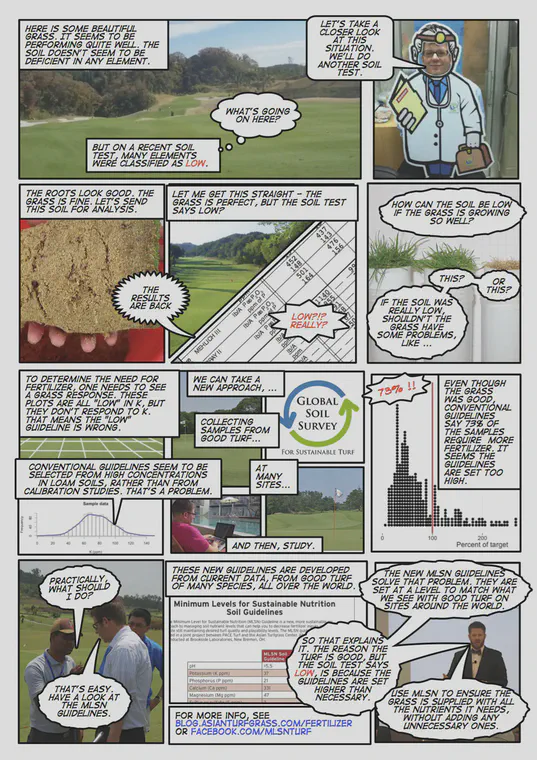Why is the grass so good, but the soil test results so bad?
I’ve been asked this question more times than I can remember. It usually goes something like this.
We had the soil tested, and it turns out we are quite low in P (or K or Ca or Mg). But the grass at this golf/park/lawn/sports facility is performing really well. How can that be? And do we really need to add that element?
The answer is, maybe it is not really low, and you may not need to add it. The reason is simple. Conventional soil testing guidelines for turfgrass, which ideally would be developed from calibration studies across multiple soil types that measure turfgrass response to different application levels of an element, have not really been developed that way.
This comic identifies the problem and explains a solution.

Conventional soil nutrient guidelines for turfgrass appear to be, in some cases, based on analyzing a large number of samples from home lawns, which tend to be on relatively high nutrient content soil, and then choosing a value above the median of those results, and identifying that as a target level. The problems with that approach, in trying to optimize turf performance, nutrient use efficiency, or manage turf in sand rootzones, or sand topdressed rootzones, are obvious.
When I speak of conventional guidelines, I am generally referring to those given in Clarifying Soil Testing: Part 3 by Carrow et al.
In the definitive textbook on this subject, Turfgrass Soil Fertility and Chemical Problems, by Carrow et al., they explained the situation with turf and soil test interpretation:
More research is needed on soil test calibration for turfgrasses. Such research should include wide ranges of soil types, and should be conducted using various turfgrass species and cultivars.
In some cases, turfgrasses have been placed in a “high” P and K requirement category, while pasture grasses were in a “low” category. This decision was based on economics, not agronomics. The cost of fertilization was not considered of primary importance for turf. Considering current fertilizer prices, scarcity of some fertilizer materials, and the environmental concerns associated with fertilization and soil nutrients, it seems quite appropriate to utilize fertilizer recommendations based on sound research.
With more awareness of this problem, and the simple solution, I’m optimistic that I’ll be asked that question about good turf and “low” soil nutrient levels a lot less. If you think you have that problem, please have a look at the MLSN guidelines and see if your good turf would still be classified as low.